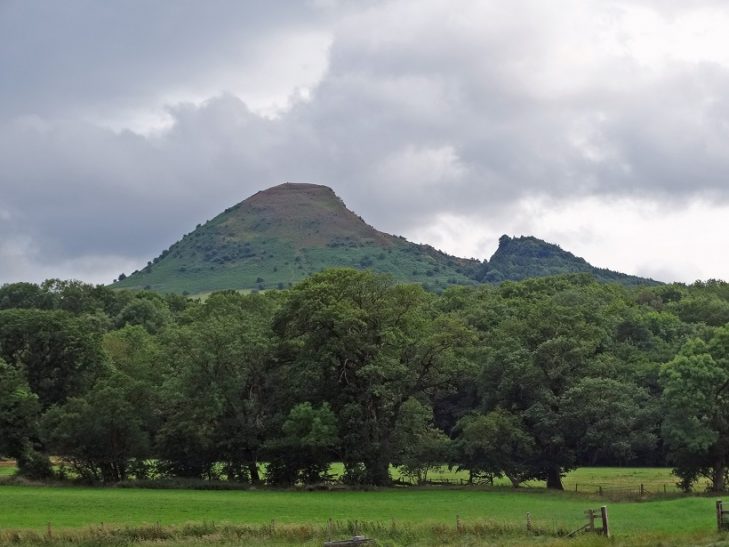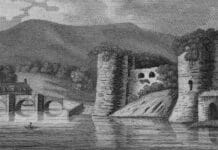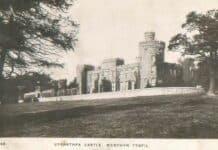CLAIRE BARRAND looks into the folklore of the Skirrid Mountain, where a curiously crooked hill is etched onto the landscape of the Black Mountains, overlooking the notoriously haunted Skirrid Mountain Inn which was named after the legendary ancient hill.
Standing less than 500 metres tall on the border of Herefordshire and South Wales, the Skirrid is situated at the east end of the Black Mountain range in Wales near Abergavenny, Monmouthshire.
The strangely misshapen mountain is called Skirrid Fawr, (taken from the Welsh, Ysgyrwd Fawr. Ysgyrwd means split or shattered, and Fawr means great).
The mountain has a distinctive chunk “missing” from its side, and it is because of its strange shape that it has many legends attached.
There is another mountain – its little sister called Little Skirrid which lies to its south thought to be caused by a landslip during ice ages times.
Locals, however, have a very different take on how the great mountain came to be broken. It has long been told that during the crucifixion of Christ, God created an immense storm, such was his anger.
The mountain was caused to shiver and tremble, and a bolt of lightning struck, causing it to break off a chunk from the great Skirrid creating the little Skirrid.
As with all folklore, there are often other varieties of the same story, and in another version, it has been said that the mountain itself was so angry at the crucifixion that it shook with fury and broke.
Skirrid Mountain also known as a holy mountain
The mountain was often referred to as the Holy Mountain or Sacred Hill because of these connections with Christ via legend.
It is thought that the land, therefore, is particularly fertile and blessed and why locals used to take handfuls of the earth to scatter onto crops, the foundations of new houses or churches for good luck and protection as well as scattering the precious soil onto coffins of loved ones.
It was custom at the burials of Catholics up until the 19th century to sprinkle coffins with the earth brought from the chapel of St Michael.
One writer from those times said that its soil was “so holy that no snail or worm could live in it”; Some of it is said to have been moved to America. Many pilgrimages were made thereon Michaelmas Eve to the summit.

Another legend that differs from the holy connection, however, suggests much darker reasons for the hill to be shaped as it is. Some folk tell of the tale when Satan tried to seduce the Archangel Michael into evil ways, but when he refused, Satan stamped on the Skirrid Mountain causing the huge piece that’s missing from the top.
On the peak of the mountain, there are the ruins of an iron age hill fort and a ruined medieval chapel called St Michaels. Services were held there until around 1680, and it was used by Roman Catholics during and after the reformation.
There is a distinctive stone there which is known as “The Devils Table”. At the end of the 19th Century, a wizard-like wise man lived there, and folk would seek him out placing their money on the stone in exchange for his advice and magic. It was believed to be him that could be heard roaring like a bull at night!
Finally, there is yet another tale of the Skirrid Fawr mountain being damaged by a local giant, or some say Wizard by the name of Jack O’Kent or Jackie Kent. His chief joy was to make the Devil look foolish. One day he had an argument with the devil over which mountain was more prominent, the nearby Sugar Loaf or the Malvern Hills.
Skirrid Fawr damaged by local giant
In one version of this story, Jack jumped off the Sugar Loaf onto the Skirrid, creating the vast footprint in the side with his heel.
In another version, because Jack was correct that the Sugar Loaf was the larger of the two, the Devil gouged a chunk of the Skirrid to add on top of the Malvern Hills to make them higher, as he did so he tripped and dropped the earth creating the smaller one. There are three standing stones at nearby Trelleck which are said to have been thrown there by Jack O’Kent during a game of quoits, having tossed them from the top of the Skirrid.
Whatever the truth behind the shattered great mountain is, we will never know, but one thing is sure, there does seem to be a great deal of mystery and magic about the area in which it stands.
I have no doubt that the ghosts that haunt the Skirrid Mountain Inn would have a tale or two of their own to tell of the stories they once exchanged many centuries ago over tankards of ale about the mysterious mountain that shadows them.









